People who live in cold places understand the importance of having a furnace to heat the house during cold seasons.
It is the next important thing after food and water for them because it is difficult to survive the weather without any source of warmth.
So, many people install a two-stage furnace to be able to use it all year round. However, a faulty furnace could mean a problematic cold season for such people.
The only way to tell if your 2-stage furnace is working is to conduct quick tests on it based on its operation. Check out the smell coming out from the furnace, the sound it makes, the general appearance, and most importantly, the temperature difference. These tests should be able to indicate if your furnace is working correctly or not.
How Does a Stage 2-Furnace Work?

A 2-stage furnace works in contrast to a 1-stage furnace with only one heat outlet and can only be on either On or Off.
In a stage two furnace, two heat outlets allow you to adjust the heat it supplies based on the desired temperature. A low and a high stage represent the degree of heat it supplies at each stage.
Generally, a 1-stage furnace has a valve that supplies gas to the burner; once the gas enters the burner, it ignites, and the heat from the burner heats the heat exchanger, which in turn heats the air in it.
The hot air is the air that heats the home once it is out. It is part of the working principle of a heating furnace, whether it is a one-stage or two-stage furnace; however, there are differences between the two based on their mode of operation and some components.
In a 1-stage furnace, the valve can only be on or Off, which means the heat supply is always high, that is, no moderate heat, and you can only turn it off if the room gets stuffy.
While in a 2-stage furnace, the valve supplying gas to the burner can be completely open (for high stage), partially open (low stage), and closed (Off).
It allows you to regulate the heat supply from the furnace and maintain a warm temperature in your home.
How Can I Tell If My 2-stage Furnace is Working Properly?
You can tell if your 2-stage furnace is in good working condition and functioning correctly by conducting tests based on its operation.
If it is a new one, you may be confused since you’re unfamiliar with how a functioning furnace should be.
In this case, you should go through the manual or contact an expert from the brand. Otherwise, using the following tests, you can determine if your two-stage furnace is good or not.
#1. Odor Test
You can carry out this test by paying close attention to the smell it emits once you turn it on.
Ideally, a furnace gives off a burnt smell in the first few hours of using it, this indicates the burning of dirt in the air, but it goes away after some time.
So, if your furnace constantly gives off that burnt smell even after long working hours, it indicates that something may be off.
#2. Sound Test
The sound test is another way to observe your furnace closely. This test is more effective when your furnace is not new and has been working for some time without giving any odd sounds.
If you’ve noticed an unusual sound different from the one it usually makes, that is also an indication of a fault in the device.
#3. Appearance Test
The appearance of your furnace should tell you if it is working or not. This test may not always mean something is wrong at that point, but do not ignore a dirty-looking furnace because the faults will manifest sooner than later.
Look out for rust and smoke stains, and check to see if dust clogs the blower fan on the inside. Once you note all these, unclog the fan and clean other parts of the furnace.
Filter Test: You can perceive dirty filters once the furnace is On. It is because the filters drive out the warm air from the vent and may sometimes trap dirt, making it dirty. Once this happens, the filters begin to smell dusty.
#4. Flame Test
You can do a flame test by opening up the burner compartment and turning on the gas to inspect the color of ignition going on in the burner compartment.
A yellowish flame indicates insufficient oxygen and more carbon monoxide, which is unhealthy for inhalation.
In addition, it is an indication of dirt trapped in the burner. A blue flame indicates sufficient oxygen and less carbon monoxide, which means the burner compartment is clean.
#5. Temperature Test
The temperature test is the most accurate test that tells you if your furnace is working correctly or not.
It is the most accurate because it can be carried out on both new and old furnaces, such that if you have never used your furnace before and you’re wondering if it is working, you will know.
First, measure your room’s temperature and the temperature of air from the furnace’s vent.
Next, subtract your room’s temperature from the air temperature and compare it to the recommended temperature rise of the air from the furnace.
The standard recommended temperature is between 35°-65° Fahrenheit, and anything below indicates a fault in the furnace.
These tests do not require you to use any special tools or have prior knowledge of a 2-stage furnace; therefore, you can afford to determine the working condition of your furnace without spending a dime.
How Can I Tell If My Furnace Is Two Stage or One Stage?
By observing, you can tell if you’re using a 2-stage or a 1-stage furnace. Even though both furnaces have the same function, they don’t have the same features.
For example, externally, you will only see two switch options on the 1-stage furnace, which are the On and Off buttons, while on a 2-stage furnace, you have three options for low stage (low heat), high stage (high heat), and Off.
Also, by the degree of heat your furnace supplies at a time, you can tell if it is a stage one or two furnace.
Since a 1-stage furnace can only be On or Off, the heat is usually very high and cannot be moderated, while a 2-stage furnace supplies only about 60% of its heat capacity on the low stage and more on the high stage.
Again, this is by observing the type of heat, but you can also inspect the components of both furnaces to know the type of furnace you’re using.
To help you figure out the type of furnace you’re using, here are some differences between the 1-stage furnace and a 2-stage furnace; here are some differences to look out for;
How Often Should a Properly Work Two Stage Furnace Cycle?
If every other factor is in check, the furnace is working correctly, the temperature is not extreme, and there is no external pressure on the furnace; it is supposed to have a cycle of 3 to 8 times per hour.
Again, this is because it works on moderate heat and does not burn much gas or consume much electricity. The temperature is not extreme, which means it is not overworking.
However, how long it runs for the entire day depends on the temperature of your environment and if you want it On.
On regular days with moderate temperatures, it can run all through the day, while on days with extreme temperatures, it will consume more gas and electricity and cycle for shorter times.
Short cycling occurs whenever the furnace overheats, and you’ll notice this if your furnace turns On and Off without reaching the average temperature or heating time of about 10-15 minutes.
Three Common Problems The 2-Stage Furnace
The 3 common problems everyone who uses a 2-stage furnace can attest to are;
#1. The High Initial Cost of Purchase
It costs about $550 to $1,700 to purchase a new 1-stage furnace while it costs about $1,500 to$2,000.
An additional installation price sums it up to $2000 to $4000, which is hugely different from the cost of a 2-stage furnace.
Unfortunately, you can do nothing to reverse the initial cost of purchasing a new 2-stage furnace, but if you’re planning to buy one, you should draft a budget to include the installation cost.
Fortunately, many people who purchase it are buoyant enough to do so, and those who cannot afford it opt for a 1-stage furnace, which isn’t bad.
#2. High Cost of Repairs
You’ll need to spend about $500 to $1000 to repair a faulty 2-stage furnace which is the same price as a new 1-stage furnace.
Regular maintenance will prevent any need for repairs. For example, if you take care of your furnace, there’d be no need for major repairs that’ll cost you so much.
#3. Lack of Longevity
Many people using a 2-stage furnace have complained about how it doesn’t last after all the considerable money spent on it.
You can extend the longevity of your furnace if you avoid overheating it. Although that is not the only cause of its lack of longevity, how you use it can shorten its longevity even more.
Conclusion
Consider your 2-stage furnace as valuable as your car or house and monitor it for signs of a fault because, looking at how expensive replacing or repairing it is, you wouldn’t want to ignore those signs.
You can detect the signs in the smells, the sounds, and the temperature difference between the recommended and measured temperatures.





